Mazatlán, Sinaloa 作者: 来源: 发布时间:2021-05-27
1. Population and Area
Pop.: 502,547
Area: 3,068.5 km2
Elev.: 1,870 masl
Mazatlán location in Mexico within the state of Sinaloa
https://goo.gl/maps/6ns3KgoVYCDk1q689
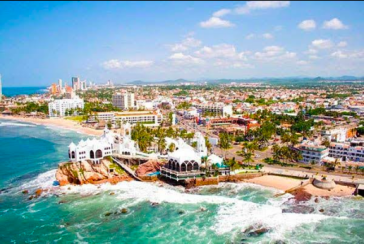
2.Natural geography
daphology
There are two types of soil that have formed here: The first type, podzolic, is characterized by a strongly white river skyline with an outer shell on a bed of brown organic detritus; these soils have a spodic horizon as a principal basis, which is classified into 5 classes: a) Smoke-ferric podzol, b) humic, c) placid, d) ferric, and e) gleyic.
The smoke-ferrous are identified by a percentage ratio between free iron and carbon of 6 or less over 6 respectively; humic are grouped by a dispersed organic matter and aluminum; the placid defined by a thin "bread" iron at or above the horizon.
The Spodic sometimes have characteristics that indicate saturation with water at a certain time of the year. Ferric soil, as its name suggests, consists mostly of iron; in the gleyic podzol, besides the spodic horizon that occurs in it, you see a picture of gley, which appears particularly saturated with water at a certain time of year.
The latter are lateritic soils, which are located on the southeast side of town, where the foothills of the Sierra Madre Occidental reach the sea. These soils are typical of the rainy tropics, presenting small tiles of two types: (red and yellow), typical of temperate humid subtropical environments.
Hydrology
El Quelite River, and the Zapote, La Noria, and Los Cocos streams form part of the water resources of the municipality in the southwestern and southeastern slopes; these streams increase its volume considerably during the rainy season.
The current of the El Quelite River recorded a catchment of 835 square kilometers, where it drained annually for an average of 107 million cubic meters with variations ranging from 78 to 163 million cubic meters. This hydrological current passing through the town of Mazatlán touches the towns of El Castillo, Las Juntas, Amapa, Los Naranjos, Milkweed, Modesto Station, and El Recreo. After traveling a distance of 100 kilometers from its source, it discharges into the Pacific Ocean. The El Zapote and Los Cocos streams drain in a southeasterly direction to end at the Presidio River, up to the villages from which they take their names.
On the southeast slope of the Sierra del Quelite is the De La Noria stream, and on the north side of it are some tributaries from the El Quelite River. The La Noria stream drains in a southeasterly direction of the town of the same name, and finally ends in the Presidio River.
El Zapote stream is formed on the western slope of the Sierra de La Noria, and moves in a southwesterly direction. In passing, it touches the towns of Zapote and El Recreo, and empties into the Pacific Ocean.
On the northern slopes of the Sierra del Salto, near the village of the same name in the state of Durango, the Presidio River moves southeastward and makes a journey of 167 kilometers. Its catchment area is 5,614 square kilometers, with an average annual expenditure of 900 million cubic meters, a maximum of 2,225 and a minimum of 550 million cubic meters. Populations on its banks are Los Cocos, El Zapote, El Placer, El Tecomate, Copala, El Recodo, Porras, Villa Unión, Alley Ostial, and Alley Rosa.
Flora and fauna
The flora of Mazatlán are tabachines, eucalyptus, laurels, and poplars. Its fauna includes birds like ducks, herons, and pelicans. There are armadillos, raccoons, and a variety of marine species such as whales, dolphins, turtles, and fish. White-tailed deer is one of the main animals that characterizes Mazatlán. Today, there are fewer animals and plants than before, due to the way humans have changed the ecosystem.
Mazatlán has several protected areas, one of which is the Protection of Flora and Fauna Area (APFF). CACAXTLA Plateau is located between the towns of Mazatlán and San Ignacio in the central part of the state of Sinaloa, and contains a portion of the coastal habitats of the state, and is the largest in Sinaloa. This wealth of habitats favors the presence of 66 species of flora and fauna listed in NOM-059-ECOL-2001 and CITES[16] and 47.5% of endemism reported for Sinaloa, plus charismatic and commercially important species. At the same time, the protected area is home to a population of 7,964 inhabitants, whose livelihood depends entirely on the extraction of natural resources in this area. The relationship between nature and society in the APFF Cacaxtla Plateau is the focus of this program.
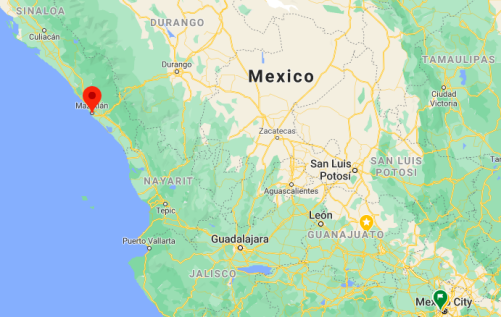
Weather
Köppen Classification: Tropical Savanna Climate
Tropical savanna climates have monthly mean temperature above 18°C (64°F) in every month of the year and typically a pronounced dry season, with the driest month having precipitation less than 60mm (2.36 in) of precipitation. In essence, a tropical savanna climate tends to either see less rainfall than a tropical monsoon climate or have more pronounced dry seasons than a tropical monsoon climate. Tropical savanna climates are most commonly found in Africa, Asia and South America. The climate is also prevalent in sections of Central America, northern Australia and North America, specifically in sections of Mexico and the state of Florida in the United States.
The Köppen Climate Classification subtype for this climate is "As". (Tropical Savanna Climate).
The average temperature for the year in Mazatlan is 77.0°F (25°C). The warmest month, on average, is July with an average temperature of 84.0°F (28.9°C). The coolest month on average is January, with an average temperature of 69.0°F (20.6°C).
The highest recorded temperature in Mazatlan is 100.0°F (37.8°C), which was recorded in July. The lowest recorded temperature in Mazatlan is 41.0°F (5°C), which was recorded in February.
There are an average of 54.0 days of precipitation, with the most precipitation occurring in July with 13.0 days and the least precipitation occurring in April with 0.0 days.
In terms of liquid precipitation, there are an average of 54.0 days of rain, with the most rain occurring in July with 13.0 days of rain, and the least rain occurring in April with 0.0 days of rain.
https://www.weatherbase.com/weather/weather-summary.php3?s=495467&cityname=Mazatlan%2C+Sinaloa%2C+Mexico&units=
Getting there and around
Get in
By plane
Mazatlán has an international airport - General Rafael Buelna International Airport (IATA: MZT) (ICAO: MMMZ), also known as Mazatlán International Airport. It receives international travelers from: Dallas/Ft. Worth, Los Angeles, San Francisco, Portland, Houston, South Shore Harbor, Salt Lake City, Phoenix, Denver, Minneapolis, Calgary, Edmonton, Regina, Saskatoon, Toronto-Pearson, Vancouver, and Winnipeg. You can reach Mazatlán from many other international origins via Mexico City.
By train
Mexico's passenger rail system including the old Nogales-Guadalajara route that passed through Mazatlán went out of service in the late 90's.
By car
Mazatlán is approximately 18 hr. drive from Phoenix, AZ. There are many considerations when bringing a car into Mexico.
By bus
Mexico has an extremely well developed bus route system and one can easily find a bus to wherever one needs to go. Mazatlán is about 12 hours away from Mexico City (~$90 one way), 6 hours from Guadalajara (~$40 one way), 15 hours from Nogales (~$50 one way), and only about 2 hours from Culiacán. Note: for whatever reason, the bus companies crank up the A/C, so bring a sweater!
By boat
Baja Ferries runs a ferry between Mazatlan and La Paz in Baja California. The trip takes 16 hours or more and leaves Mazatlan almost daily (check for weekend departures). Also, Mazatlán has a busy port which accommodates a number of cruise ships that sail up and down the western coast of the Americas. From the port, it's a five-minute taxi ride to the southernmost hotels or fifteen minutes to the more modern (and more expensive) places to the north.
Get around
By taxi
Besides normal taxis, the tourist areas (Zona Dorada and Centro Historico) always have many small white open-topped taxis called pulmonías that look like dodgem cars. These are unique to Mazatlan. Although you'll never have to wait long for one (they're always whizzing back and forth) ask the price before you get in and then bargain. The correct price will usually be about 30% less than the original quote. Don't overdo the haggling, though. It'll cost you less than $4 US to go between downtown and the tourist district. You may want to give the driver a little tip as appreciation for a safe and enjoyable journey.
By bus
There are two different types of public transport buses that run in Mazatlán. The larger green ones run along the main tourist strip right along the water and either turn off at Rafael Buelna Anvenue or continue on along the Malecon to downtown. These are the equivalent of coach buses, they are very well air-conditioned and in great shape. They cost around $.70 US (9 pesos) per trip. The city is also served by regular local buses which are cheaper and only cost around US $.45 per trip (5 or 6 pesos). Be sure to check the windshield of the bus as the bus route is typically written on it. These buses serve the entire city well but can be confusing without a thorough knowledge of the system. The buses that go along the Malecon between downtown and the tourist district are the "Sabalo-Centro" buses.
By car
Mazatlán is approximately on the intersection of highway 15 and highway 40. In-town transportation is mainly motorized, except for the Centro Histórico, which is a very nice walking district. For tourists, cabs can be found in sparse supply compared to the number of pulmonías in town. Pulmonías are essentially open-air taxis, many of them old Volkswagens. They're as safe as any cab, just as cheap, and offer a far better view of the city on a nice day.
AGA Rent a Car, Av. Camaron Sabalo #312-A, Zona Dorada, . AGA Rent-A-Car has been renting vehicles to travelers and local renters since 1989. Their first location opened in Mazatlan, Sinaloa, Mexico and they have since expanded to serve Los Mochis and Culiacan, with locations both at the the airport and in town. There are the usual competing companies (Hertz, Avis, etc), but AGA may be the least expensive.
https://wikitravel.org/en/Mazatlan
3.GDP
GDP: 1412 M USD
4. Industry
Tourism and fishing are the main, legal industries in Mazatlán which is the unofficial center of the narcotics trade in Mexico. The city houses the main beach resorts, and has the second largest fishing fleet in Mexico. The most processed seafood products in the city are shrimp and tuna. The first Mazatlán hotel with a restaurant inside was named Canton-La Fonda and became operational in 1850. It was owned by a Chinese immigrant, Luen-Sing, which called the establishment the Luen-Sing Hotel. In 1864, there were three hotels and three restaurants in Mazatlán, with more opening in the late nineteenth century. Today, more than twenty miles of beaches are the main attraction, and the city contains a large number of hotels, restaurants, bars, and shops. The city is also home to the Pacífico brewery, a coffee factory, and two power plants.
5. Touristic sites
Mazatlán Lighthouse
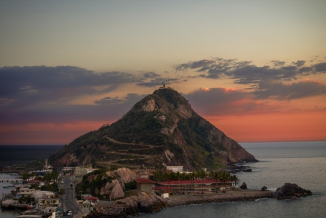
The Mazatlán lighthouse, called El Faro Lighthouse, is located at the peak of Cerro del Creston, at the southern end of the peninsular city of Mazatlán. The lighthouse has the distinction of being settled in what was formerly an island, and has a length of 641 meters by 321 meters and a height of 157 meters, making it the highest natural lighthouse in the Americas, and one of the highest operating lighthouses in the world.
The first use of the Isla de Creston as a lighted marine signal was in 1828. The light facilities, located on top of an imposing hill, were very modest, consisting of only a small stone structure on which fires, fueled by whale oil and wood, or coconut chips, were lit. The fires were fed wood and coal, allowing them to produce a dim light that could only be seen within walking distance, making it of little help to seafarers, especially in bad weather.
El Faro became the answer to the problem. First lit over the Pacific Ocean in 1879, the lighthouse's original lamp was constructed in Paris. It was made of an oil lamp surrounded by mirrors, and a Fresnel lens to focus the light. This allowed El Faro's light to be seen from a much further distance, and thus give better navigation services, leading to approaches made with greater precision.
In 1905, the lamp was converted to hydrogen gas, and was made to be able to revolve in a full circle. The final update of the light source came in 1933, when it was converted to electricity, which is what is still there today. In order to emit its powerful light, El Faro uses a 1,000 watt bulb, which is focused by a Fresnel lens.
Historic Centre

Most of Mazatlán national historic landmark buildings are in the Centro Histórico, the quarter developed in the 1820s and 1830s.
In that time Mazatlán grew from a village on a swampy river estuary to the largest port on Mexico’s Pacific coast and the capital of Sinaloa.
One of the trademarks of old Mazatlán is its “pulmonías “, golf cart-style taxis with awnings that zip around its streets.
The quarter had fallen on hard times by the 1980s but has been spruced up since the 2000s, and its painted Neoclassical houses have been restored to its 19th-century glory.
You’ll keep returning to this charming part of the city for meals, street food (the shrimp tacos and tamales are a treat), souvenir shopping and to browse art galleries.
The neighbourhood turns into one large outdoor stage in June for the Día de la Música, when diversity of free concerts takes place.
Plaza Machado
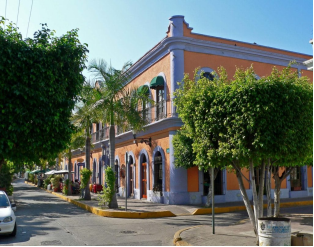
Named for its financier, the Filipino pearl-diving entrepreneur Juan Nepomuceno Machado, Plaza Machado was plotted on swampy ground in 1837. The square is the most picturesque sight in the Centro Histórico, with rows of palms and hardwood trees, formal flowerbeds and an elegant wrought-iron bandstand at its centre.
Take a few minutes to admire the houses fronting the square, painted in earthy tones, and consider the diverse characters that have visited this spot over the last 180 years.
There were 49ers during the California gold rush of 1849, Hollywood actors in the 1930s and 40s and the feted soprano Ángela Peralta, who passed away at this place in 1883. According to legend, she gave one last aria from her balcony before succumbing to yellow fever.
Mazatlán Aquarium
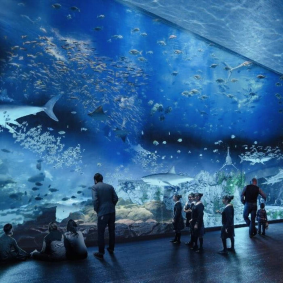
The only standalone aquarium on Mexico’s pacific coast, this attraction has more than 50 tanks showing off the species that inhabit the Pacific next to Sinaloa, as well as freshwater life from tropical regions worldwide.
There are over 250 species, including sea turtles, sharks, octopuses, piranhas, clownfish, eels and mudskippers that can breathe out of the water and use their fins as legs.
The marquee tanks are the Oceanic Fish tank, holding almost two million litres and the stingray pool containing six different stingray species.
The aquarium also has an extensive outdoor environment, with an aviary and botanical garden.
Under the branches of a magnificent elephant-ear tree you can watch birds of prey take flight.

MAZATLAN: Top 10 Tips To Experience Mazatlan, Mexico
https://youtu.be/ZMsR7DLnUdc
6. History and Culture
Mazatlán early settlers
According to historians, Indigenous groups were in the region of Mazatlán prior to the arrival of the Spanish. These groups included the Totorames, who lived from the south bank of the River Piaxtla, to the Río de las Cañas, as well as the Xiximes, who lived in the mountains in the bordering state of Durango.
Until the early 19th century, Mazatlán was a collection of huts inhabited by indigenous people whose major occupation was fishing, according to Abel Aubert du Petit-Thouars, a French explorer. In 1829, a Filipino banker named Juan Nepomuceno Machado arrived and established commercial relations with vessels coming to Mazatlán from far off places such as Chile, Peru, the United States, Europe, and Asia Pacific. By 1836, the city had a population of between 4,000 and 5,000.
Foundation of the city, colonial period
During the early years of the Spanish conquest in Sinaloa, the region currently occupied by the municipality of Mazatlán remained uninhabited. The nearest town was Chametla, which was occupied by the Spanish in 1531, and lent its name to the province, despite being abandoned shortly afterward.
In 1534, the Valley of Mazatlán was divided into 25 Castellanos by an unknown person who did not stay for long. In 1576, Don Hernando de Bazán, Governor and Captain General of Nueva Vizcaya, sent Captain Martin Hernandez with his father, brothers, and soldiers to occupy the site of Mazatlán, granting them land and titles in return. The Captain's claims were ratified in the City of Durango in 1639, and endorsed in the same city in 1650.
Nuño de Guzman's entry to Sinaloa in 1531, and the appointment of the conquered lands as provinces, prompted the internal territorial division of the State. Chametla was occupied by the Spanish, and listed the province extending from the Rio Cañas Elota to the boundary with the province of Culiacan. Both provinces belonged to the kingdom of New Galicia.
In 1565, the town of Chametla was gradually diminished by ongoing Indian raids. That year, Captain Francisco de Ibarra recovered the territory south of the state, rebuilt Chametla, and founded the Villa de San Sebastián (known today as Concordia), and awarded the region to New Vizcaya. The provinces under his jurisdiction included the villages of San Sebastián, Mazatlán and its port, Charcas Copala Royals, and Finance Panuco.
During the last years of the seventeenth century and early eighteenth century, the territory within Sinaloa remained unchanged, until 1732, when the provinces of Sonora and Ostimuri were united, as were the provinces of Sinaloa, Culiacan, and Rosario, with San Felipe and Santiago being the principal cities.
In 1749, Sinaloa was divided into five provinces with their mayors and lieutenancy: Maloya, with jurisdiction over Chametla, Rosario, and San Jose; Copala, with jurisdiction over San Ignacio, Piaxtla, and Mazatlán; Culiacán, with jurisdiction over Badiraguato, and Sinaloa, which bordered the Mayor River.
In 1786, the intendant system was implemented due to the need to establish a provincial government. Arizpe Municipality was formed out of the territories of Sonora and Sinaloa. That year, the first mayor, Garrido Durán, established eleven subdelegations, eight of them in Sinaloa, with Mazatlán being within the subdelegation of Copala, which was later called San Sebastián.
Independent Mexico
Among the first decrees that the legislature enacted was that the addition of each of the eleven districts, and this union, corresponding to the Union Villa Mariano Balleza, be given the name of one of the leading insurgents, parish priest Dolores Hidalgo, on the night of September 15, 1810.
In 1813, the Cadiz constitution came into effect. Article 310 of that constitution provided for the installation of local councils in towns that had more than 1,000 inhabitants. In 1814, Fernando VII repealed that constitution but it was later reinstated in 1820, and the first municipalities in Sinaloa were founded.
In the late eighteenth and early nineteenth century, Mazatlán was a native fishing village located north of Cerro de la Aduana. In 1821, it was declared the first port of Mazatlán on Mexico's Pacific coast.
Jurisdictionally, Mazatlán remained dependent on the sub-delegation of San Sebastian, unaffected by the divisions between the states of Sonora and Sinaloa. In 1824, they got together to form the Western State. After the imposition of new internal divisions of five departments and municipalities divided into parties, Mazatlán was in the department of San Sebastian, which was formed with the parties of its name, San Ignacio and the Rosary, and it extended to the River of Reeds.
In 1830, the Western State was divided into two states. The first constitution of the state of Sinaloa, promulgated on December 12, 1831, divided the territory into eleven districts with their respective parties, leaving the district town of La Union separated from Concord and San Ignacio.
According to the French navigator Abel Aubert du Petit-Thouars, a Spanish banker named Machado, through his commercial activities, gave impetus to the village of Mazatlán in 1836, then a village of four to five thousand people. It subsequently became the largest port on the Mexican Pacific coast.
In 1846 during the Mexican-American war, Mazatlán was invaded and occupied by the U.S. military as part of the U.S. Pacific Coast campaign. In 1859, the port was blockaded by Captain Sidney Grenfell of the British steamship H.M.S. Amethyst. On November 13, 1864, the French Army and the Imperialist forces took possession of Mazatlán, until they were deported on November 13, 1866 by General Ramón Corona's forces. After customs officials seized twenty-three ounces of gold from the British warship Chanticleer on June 18, 1868, which at the time was blockading the port, its captain, William H. Bridge, threatened to bomb the city on November 22.
During the California Gold Rush, fortune hunters from the United States' East Coast sailed from New York Harbor and other Atlantic ports to Mexican ports in the Gulf of Mexico. After landing, the aspiring miners travelled over land for weeks to Mazatlán, where they would embark from the port to arrive in San Francisco in another four to five weeks.
When Félix Zuloaga Tacubaya proclaimed the Plan of Ignoring the Constitution of 1857, the garrison of the Plaza de Mazatlán did not remain outside this proclamation, and on the first of January, 1858, the Plan of Mazatlán was proclaimed, which followed Zuloaga's Plan.
The capital of Sinaloa, until the year 1853, had been Culiacán. However that year, the capital was transferred to Mazatlán. On July 22, 1867, the federal government passed a law that forbade state capitals to also act as ports. As a result of this law, on September 20, 1873, the State Legislature decreed that Culiacán would be the state capital again.
The Siglo XIX constitution of 1852 decreed a new internal division in Sinaloa, which reduced it to nine districts by removing San Ignacio, which had been annexed to the Cosalá, and Choix, which had been annexed to El Fuerte. It also amended the name of the district from Villa de la Union to the port of Mazatlán. That same constitution also decreed the headquarters and council facility policies in each district.
In 1861, the political headquarters were removed and turned into prefectures, and the same year the State Legislature adopted the Act on Municipalities. In 1868, the district had five municipalities in Mazatlán; one in the center and the other four in Villa Union, Siqueiros, La Noria, and The Milkweed.
On the morning of November 13, 1864, French Navy ships fired twelve cannon shots into the city, causing minor damage to several homes, but not causing any deaths. The attack stopped when the prefect of the city made known to the invaders that the Mexican Army had left the square and the city was formally ceded to the French.
The Mazatlán Times was a weekly published by the American A. D. Jones. The first issue appeared on May 12, 1863. The publisher boasted that his was the only weekly English-language newspaper, not only in Mazatlán and Sinaloa, but throughout Mexico.
In 1873, according to the census of the State, the District of Mazatlán was reduced to three municipalities: Mazatlán, Villa Union, and La Noria. Siqueiros had been annexed in 1870 to the central municipality, and The Milkweed to La Noria.
Porfiriato
Mazatlán's lighthouse (El Faro) began operating in mid-1879. The maritime signals were manufactured in Paris, France, containing a large oil lamp with mirrors, and a Fresnel lens to focus the light. Since the light was static, from a distance it was often mistaken for a star. By 1905, this lamp was converted to a revolving lamp. During that period, the Mazatlán lighthouse was considered to be the naturally highest in the world. Today, the 1000 watt bulb can be seen for 30 nautical miles (60 km). Near the lighthouse shore, famous "divers" (called this even by the Spanish-speaking inhabitants of Mazatlán) perform daring jumps off high rocks into the Pacific Ocean, for tips from onlooking tourists.
On June 26, 1880, Jesus Ramirez, former general in command of 400 men, stormed the garrison of the square and appropriated Mazatlán. The city was subsequently bombed again by the Mexican warship the Democratic, which, during its attack, killed and wounded a high number of women and children. Of the 24 cannon shots fired, only three hit the army headquarters, and the rest landed on neighboring houses.
Angela Peralta (1845–1883), a Mexican opera diva famed throughout the world, died of yellow fever in Mazatlán shortly after her arrival in the port. Legend has it that she sang one last aria from her hotel balcony overlooking the Plazuela Machado. Her memory is held dear by Mazatlecos to this day, and the restored Angela Peralta Theater by the Plazuela keeps her memory alive.
The Cerveceria del Pacífico was founded in the city in 1900 by German immigrants.
Mexican Revolution
In 1912, the municipalities enacted law No.21 as a form of internal division of the State. However, it wasn't until 1915 that the law was abolished by the political directorate, when it erected the first free communes.
With the publication of the decree creating the municipality of Mazatlán in the official newspaper on April 8, 1915, independent life began in the region. The Constitution of 1917, culminating in the first constitutional governor, General Ramón F. Iturbe, born in Mazatlán, confirmed the sixteen municipalities into which the state was divided, which would then be subdivided into receiverships and police precincts.
The City of Mazatlán has the dubious distinction of being the second city in the world after Tripoli, Libya, to suffer aerial bombardment (although the local historical display at the plazuela claims that Mazatlán was the first). During the Mexican Revolution, General Venustiano Carranza (later president), intent on taking the city of Mazatlán, ordered a biplane to drop a crude bomb of nails and dynamite wrapped in leather on the target of Neveria Hill adjacent to the downtown area of Mazatlán. The crude bomb landed off target on the city streets of Mazatlán, killing two citizens and wounding several others.
Modern
Mazatlán is also the hometown of Pedro Infante, one of the most popular actors and singers of the Cinema of Mexico's golden years.
Mazatlán was well regarded by film stars such as John Wayne, Gary Cooper, John Huston, and others of their generation as a sportfishing mecca. The hotels along Olas Altas flourished during the 1940s, 1950s and 1960s, supporting this vibrant trade.
In the 1970s, tourism in Old Mazatlán declined as newer venues catering to Western tourists opened on the expanses of beach to the north of the city ("Zona Dorada"). As an example of Mazatlán's tourism expansion, one of the largest timeshare providers in Mexico, Grupo Vidanta, was founded in 1975 with the inauguration of Paraíso Mazatlán (Mazatlán Paradise). This time also saw the expansion of the Hotel Playa Mazatlán, and the construction of many others, a trend that continues to this day.
Next to Infante, Lorena Herrera, one of the most famous actresses and singers in Mexico and Latin America during the final decades of the 20th Century and the first decades of the 21st century, is Mazatlán's most famous native. German-born telenovela star Sabine Moussier, a stablemate of Herrera's—both have been under Televisa contract since the 1990s—also grew up in Mazatlán. Hollywood and Broadway actress Sara Ramirez is also a Mazatlán native.
As the 21st century began, the Centro Histórico was rediscovered by newcomers and locals alike, spurring a renaissance of restoration and entrepreneurial endeavors. Once-fine homes that had fallen into literal ruin were restored to their former glory as family homes and boutique businesses. The city has assisted by upgrading infrastructure such as better water, sewer, and electrical services.
7.Contact Information
City Mayor: Luis Guillermo Benitez Torres

Contact number: +52 (669) 915 8071, ext. 2101
Govt. Office Address: Angel Flores , s/n, Col. Centro, Mazatlán, Sin.
Twitter: https://twitter.com/quimicobenitez
FB: https://www.facebook.com/luisguillermo.beniteztorres
Website: https://www.tlaquepaque.gob.mx/views/index.php
E-mail: presidencia@mazatlan.gob.mx
